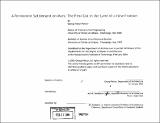A permanent settlement on Mars : the first cut in the land of a new frontier
Author(s)
Petrov, Georgi Ivanov, 1977-
DownloadFull printable version (21.28Mb)
Other Contributors
Massachusetts Institute of Technology. Dept. of Architecture.
Advisor
Ann M. Pendleton-Jullian.
Terms of use
Metadata
Show full item recordAbstract
Humans have been fascinated with the planet Mars for thousands of years. Only in the last half a century has it been possible to contemplate sending people to our celestial neighbor. Since then, a rich discourse has evolved concerning how to achieve this goal. The discussion, thus far, has been dominated by mechanical and aerospace engineers with marginal participation from architects. This thesis explores the issues involved in conceiving and constructing habitats on the surface of Mars that can be addressed through architecture. The goal is to design sustainable and pleasant spaces for humans living in extreme conditions, in order to facilitate the development of a viable community by a small group of people living in isolation, within the realistic engineering constraints of safety, efficiency, and expandability. The first permanent settlement on Mars is considered at architectural and planning scales. A detailed architectural design is developed for the first phase of construction to house 24 people, situated at the base of a set of mesas in Candor Chasma, using in-situ derived masonry construction and inflatable technology imported from Earth. A primary consideration in the design is the expectation that the first step will provide the vision for an expanding community. A dual band linear growth pattern along which spaces are arranged through a conceptualization of the relationship between humans, plants, and machines is envisioned and a possible configuration of the settlement when it reaches a population of 100 is presented.
Description
Thesis (M. Arch.)--Massachusetts Institute of Technology, Dept. of Architecture, 2004. Includes bibliographical references (p. 97-99).
Date issued
2004Department
Massachusetts Institute of Technology. Department of ArchitecturePublisher
Massachusetts Institute of Technology
Keywords
Architecture.